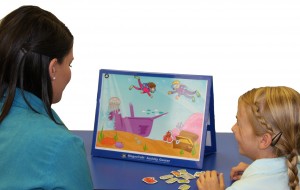
Children’s early language development includes learning to use and understand lots of individual words. As children develop a larger vocabulary they begin to understand that some words are often used together such as “shoes and socks”. They begin to understand that some words have similar meanings such as “big and huge” and others are opposites such as “big and little”. They also begin to learn categories such as: food, fruit, and clothes. Understanding how words relate to each other is important for learning in a range of subject areas in school and also helps children retain new knowledge by connecting new ideas with old and grouping related information together in memory.
Words can be related by:
- Being used together e.g. shoe and sock
- Having the same function e.g. scissors and knife
- Being in the same category e.g. apple and banana
- Being opposites e.g. big and little
- Having similar meaning e.g. small and little
- Being part of a whole e.g. tree and branch
Here are some fun ways to help children develop word relationships:
Make a collection of pictures of things that go together by either using photos from junk mail, clipart or by taking photos of things around the house. Word pairs might include: shoe and sock, toothbrush and toothpaste, dustpan and broom, knife and fork etc. Paste your pictures onto cardboard and cut into individual cards. Help your child learn the names of each picture and talk about how each item relates to it’s partner. For children who can read well you can simply write words onto cards. You can download suitable pictures from the "descriptive language and partners" game here. There also printable picture sheets on our pintrest page here.
Play the following games to develop your child’s understanding:
What’s missing? Sort the cards into pairs and place each pair together on the table. Ask your child to cover their eyes while you turn one card from each pair face down. Can they look at the cards and guess which cards are turned over. Now put all the cards face up and mix them all together. Ask your child to close their eyes while you take away just one card. Can they match all the remaining cards and guess which one is missing?
Memory match and snap. Use your cards to play these fun games while practising matching the pairs.
Go fish. Deal out five cards for each person and place the rest face down in a pile in the middle. Take turns to make pairs by asking for the pictures that go with the ones in your hand “I have a shoe, do you have a sock?” If you do not get a matching card take a card from the pile in the middle. The winner is the one with the most cards at the end.
Find it. Give your child about five cards from the pack.
Ask your child to go around the house and find something they would use with each of the items.
Here are some other ideas for word relationships:
Parts and wholes. Print or draw a large picture of an item such as a tree. Cut the picture into parts such as the trunk, branches, roots and leaves so that it is like a jigsaw puzzle. Practice naming the parts as you put the puzzle back together. Make a second puzzle of a different item such as a person. How are the parts of the person and the tree the same or different?
Roll the dice. Write the names of categories such as food, clothes, toys, body parts, transport, animals on some cards. Place the cards face down on the table. Choose a card and roll the dice. Can you think that number of items in the category you have chosen?
Word ladders. Choose a describing word such as “big”. Write down all the words you can think of that mean big such as big, large, enormous, huge and so on. Draw a ladder on a sheet of paper and arrange the words in order with the least big at the bottom and the biggest one at the top.
Visit our downloads page for more information and ideas about language and learning.
If you are concerned about your child's language or learning browse our website to see how speech pathology can help.
Related Blog Posts
If you liked this post you may also like:
Listen & understand 101
Learning to Move
10 ways to use puppets
Questions for preschool



